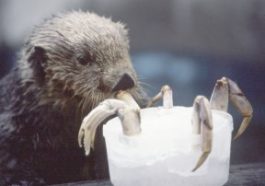News Detective: Otters at the Aquarium
Whoosh! The sound of rushing water comes from large pipes on my right. A damp fishy smell wafts off a wall of bubbling, water-filled tanks nearby.
I am on a “behind-the-scenes” tour in the basement of the Seattle Aquarium with a group of other reporters. We are there to learn what biologists and curators do from day to day. This hidden work creates the magical undersea world that aquarium visitors see every day upstairs.
One of the special things about being a reporter is having the chance to see how the world works from the inside out. We can ask questions of experts who may not have time to talk to every curious visitor. Then we describe what we saw to others who might not have the chance to, say, troop around with an aquarium scientist.
Mammal biologist Catherine Minnig had led us past sea lions, shore birds, and what looked like real waves crashing on a beach. We’d just descended a clanking metal staircase to what she jokingly called the “dungeon.”
Instead of being dark and scary, though, it was fascinating.
Giant machines next to us noisily pumped and filtered gallons of aquarium water. A raised pool held a wild green sea turtle that aquarium staffers were nursing back to health.
 |
| At the Seattle Aquarium, a sea otter snacks on the legs of a crab frozen into a popsicle. |
| Seattle Aquarium |
Minnig opened tall, chrome freezers worthy of a restaurant to show us bowls of shrimp, and trays of crabs, clams, and fish meant for the aquarium animals’ dinners.
Nearby, an eraser-board chart noted that a river otter named Waadah had enjoyed playing with a sweet potato yesterday. Below the chart, a box overflowed with toys and odd contraptions used to entertain the animals, especially the sea otters.
Minnig explained that staffers fill the tubes, toys, and large blue “boomer ball” with frozen shrimp or clams. Freezing seafood in other bowls and tubes creates crab-sicles or krill-pops for the sea otters to crunch and play with.
The reporters around me wrinkled their noses at the fishy smells and laughed at the idea of popsicles made of clams. Asked about the icy food, Minnig replied that the frozen toys aren’t just for fun. They’re an essential element of caring for animals in captivity. Scientists call it “enrichment.”
Smart animals such as sea otters get bored if they can’t work on puzzles and use their minds as they would in the wild. Bored animals get sick and depressed. Visitors also learn more if they see active, happy animals. So, the people at the aquarium spend a lot of time thinking up fun activities for the animals.
We were about see enrichment in action!
Minnig led us upstairs to the sea otter enclosure. The otters inside twirled and splashed in the water. There was Lootas, a 6-year-old female, her grown-up pup, Aniak, and the smallest, Calypso, a young orphaned pup from the wild that Lootas has taken under her wing. The group of reporters waited, eagerly pressing up against the glass.
A young visitor to the aquarium, 11-year-old Kailey Cockell, was obviously enjoying the otters, too. “They’re the most exciting animals here,” she told me. “They just can’t hold still and seem very smart!”
Then a woman appeared with a big block of ice chock-full of krill and butter clams. She also laid out a row of clamshells on the deck.
Lootas sprang into action. She quickly grabbed a clam in its shell, plunged back into the pool, and slammed the clam against the concrete wall until the shell cracked. The other otters followed suit, and the sounds of cracking and crunching filled the air.
Then Aniak went for a chunk of the seafood popsicle. Pretty soon, all three otters were rolling and diving in the water, tussling with each other over the chunks as they broke off, and gnawing away at the icy corners. As a caring adoptive mother, Lootas often pulled off a large piece of clam and swam over to stuff it into Calypso’s mouth.
For several minutes, every reporter was silent, happily entranced by the scene. I think they were all thinking what I was: “This is what I love about being a science reporter!”